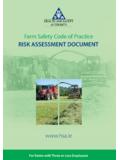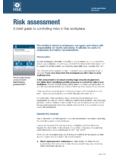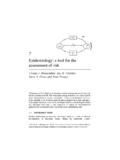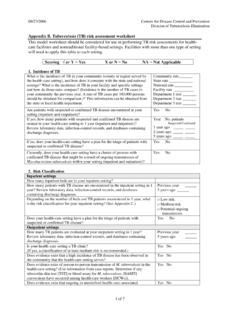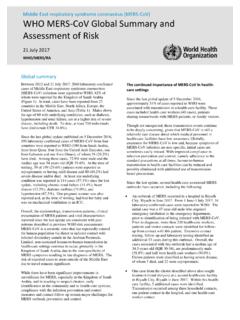Transcription of Human Health Risk Assessment of Artificial Turf Fields ...
1 1 Human Health Risk Assessment of Artificial turf Fields Based Upon Results from Five Fields in Connecticut Connecticut Department of Public Health Program in Environmental and Occupational Health Assessment July 28, 2010 2 Study Authors Gary Ginsberg, Brian Toal, MSPH Connecticut Dept of Public Health Environmental and Occupational Health Assessment Hartford Connecticut 860-509-7740 Acknowledgements This Assessment was performed with the assistance of a summer intern from Clark University, Tara Kurland, who helped with the field work, report writing and toxicological Assessment of benzothiazole.
2 The report was reviewed by staff within CTDPH, the University of Connecticut Health Center, Section of Environmental and Occupational Medicine, and the Connecticut Dept of Environmental Protection. CTDPH received no special funding to conduct this risk Assessment . The risk Assessment and overall study report were also reviewed by the Connecticut Academy of Science and Engineering (CASE); this risk Assessment reflects the recommendations of their June 15, 2010 report. The field and laboratory work was funded by the Connecticut Dept of Environmental Protection. 3 Executive Summary Questions have been raised about possible exposures when playing sports on Artificial turf Fields cushioned with crumb rubber infill.
3 Rubber is a complex mixture of various chemicals including volatile organic chemicals (VOCs), semi-volatile organic chemicals (SVOCs) and metals. Some components have toxic and carcinogenic properties. Exposure is possible, primarily via inhalation, given that chemicals emitted from rubber can end up in the breathing zone of players and these players have high ventilation rates. Previous studies from Europe and the United States provide useful data but are limited particularly with respect to the variety of Fields and scenarios evaluated. To enhance this database, the State of Connecticut undertook a multi-disciplinary study of Artificial turf Fields involving field investigation, laboratory offgas studies and Human Health risk Assessment .
4 These reports were reviewed by the Connecticut Academy of Science and Engineering (CASE) and their comments have been incorporated into the final report. The current investigation involved air sampling at 1 indoor and 4 outdoor Artificial turf Fields under summer conditions in Connecticut. On- field and background locations were sampled using a variety of stationary and personal samplers. A total of 27 chemicals of potential concern (COPCs) were found to be above background and possibly field -related on both indoor and outdoor Fields . These COPCs were entered into separate risk assessments for outdoor and indoor Fields and for children and adults.
5 Exposure concentrations were pro-rated for time spent away from the Fields and inhalation rates were adjusted for play activity and for children s greater ventilation than adults. Toxicity values (cancer unit risks , RfCs, acute targets) were taken from national databases or derived by CT DPH. In general, conservative public Health protective assumptions were made in calculating risks , especially with regard to the inclusion of detects from personal samplers that may not have been field related. As such, this represents a screening level Assessment that is likely to overestimate risk. In spite of the conservative nature of the Assessment , cancer risks were only slightly above de minimis levels for all scenarios evaluated including children playing at the indoor facility, the scenario with the highest exposure.
6 The calculated risks are well within typical risk levels in the community from ambient pollution sources and are below target risks associated with many air toxics regulatory programs. Further, the main risk driver, benzene, was only above background in personal monitoring samples and so may be more related to the sampling equipment or host than being field -related. Chronic non-cancer risks were not elevated above a Hazard Index of 1. The Hazard Index for acute risk was also not elevated above 1 but was close to 1 for children playing at the indoor field . The main 4 contributor to this Hazard Index was benzothiazole, a rubber-related SVOC.
7 This presents an uncertainty regarding the potential for benzothiazole and other volatile irritants to create a slight irritation response in sensitive individuals playing indoors. Based upon these findings, the use of outdoor and indoor Artificial turf Fields is not associated with elevated Health risks . However, it would be prudent for building operators to provide adequate ventilation to prevent a buildup of rubber-related VOCs and SVOCs at indoor Fields . The current study did not evaluate new Fields under hot weather conditions and so the potential for acute risks under this circumstance is another uncertainty.
8 The current results are generally consistent with the findings from studies conducted by New York City, New York State, the USEPA and Norway which tested different kinds of Fields and under a variety of weather conditions. Thus, it appears that the current results are reasonably representative of conditions that can be encountered at indoor and outdoor crumb rubber Fields , although this tentative conclusion could benefit from the testing of additional Fields . Table of Contents I. Introduction .. 5 II. Review of Air Sampling Results a. Selection of Contaminants of Potential Concern .. 6 b. Pattern of VOC and Benzothiazole Detections.
9 9 III. Exposure Assessment a. Exposure Scenarios .. 12 IV. Toxicity Assessment .. 13 V. Risk Characterization a. Calculations .. 16 b. Results .. 17 c. Discussion .. 18 d. Current Results in Relation to Prior Studies .. 22 e. Limitations .. 25 VI. Conclusions .. 26 VII. References .. 27 Tables Figures 5 Appendix A. Benzothiazole Toxicity Profile Appendix B. Spreadsheets 6 I. Introduction Questions have been raised about potential exposures and Health risks associated with playing on Artificial turf Fields cushioned with crumb rubber.
10 Rubber is a complex mixture of natural compounds and industrial chemical intermediates, a number of which have the potential to be a Health risk if there is sufficient exposure. CTDPH developed a fact sheet in October 2007 regarding the potential exposures and risks associated with offgasing from Artificial turf Fields highlighting research from Europe and California. The fact sheet identified a number of limitations and uncertainty in the existing database. Since then, a field investigation and risk Assessment has been conducted for two Fields in NYC (NYSDEC 2009; TRC, 2009) and for 4 Fields in various states across the country (USEPA, 2009).











